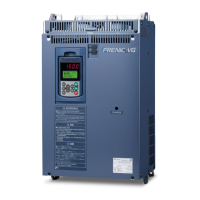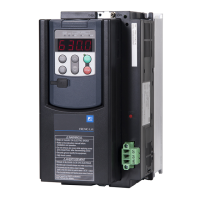5-1
5 Maintenance and Inspection
Proceed with the daily inspection and periodic inspection to prevent malfunction and ensure long-term reliability.
Note the followings in the inspection works.
5-1 Daily inspection
During opera t ion of the inverter, a visual inspection for abnormality is performed externally without removing the
covers.
The inspection usually covers the followings:
① The performance (satisfying the standard specification) is as expected.
② The environment satisfies the standard specification.
③ There are abnormal sounds, vibrations, or odors.
④ There are no indications of overheating or no discoloration.
5-2 Periodical inspection
Periodical inspection must be performed after stopping operations, turning off the power supply, and removing
the front cover.
Note that after turning off the power supply, the smoothing capacitor in the DC section in the main circuit takes
the time to discharge. To prevent electric shock, check that the voltage has dropped below the safety value (25V
DC or below) using a multimeter after the charge lamp (CHARGE) goes off.
WARNING
• Start the inspection at least ten minutes after turning off the power supply.
Further check that the charge lamp (CHARGE) goes off, and that the voltage is
25V DC or below between the terminals P(+) and N(-).
Electric shock may result.
• Only authorized personnel should perform maintenance and component
replacement operation.
Take off metal jewelry such as watches and rings.
Use insulated tools.
Never modify the product.
Electric shock or injury may result.
Table 5-2-1 Periodical inspection list
Check part Check items How to inspect Evaluation criteria
Check the ambient temperature, humidity,
vibration, atmosphere (dust, gas, oil mist, water
drops).
Conduct visual
inspection and use the
meter.
The specified
standard value must
be satisfied.
Environment
Is the area surrounding the equipment is clear
without left foreign body such as tool or
dangerous body.
Visual inspection The area is clear.
Voltage
Are the voltages in the main and control circuits
normal?
Measure using the
multimeter.
The specified standard
value must be satisfied.
Is there abnormal sound or vibration?
Visual and aural
inspection
Not abnormal
Are nuts or bolts loose? Tighten. Not abnormal
cover
Is there deformation or damage?
Is there discoloration as a result of overheating?
Are there stains and dust?
Visual inspection Not abnormal
Are there loose or missing nuts or bolts?
Tighten. Not abnormal
Common
Are there deformation, crack, damage, and
discoloration due to overheating or deterioration
in the equipment and insulation?
Are there stains and dust?
Visual inspection
Not abnormal
Note: Discoloration of
the bus bar does not
indicate a problem.
Conductor
and wire
Is there discoloration or distortion a conductor
due to overheating?
Are there cracks, crazing or discoloration of the
cable sheath?
Visual inspection Not abnormal
Terminal
block
Is there damage? Visual inspection Not abnormal
Main circuit
Smoothing
capacitor
Is there electrolyte leakage, discoloration,
crazing or swelling of the case?
Is the safety valve not protruding or are valves
protruding too far?
Visual inspection Not abnormal

